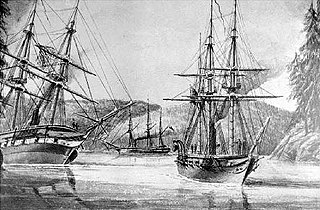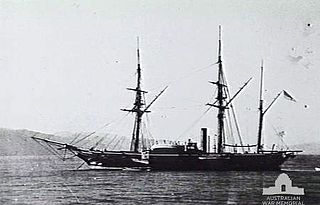
HMSGannet is a Royal Navy Doterel-class screw sloop-of-war launched on 31 August 1878. It became a training ship in the Thames in 1903, and was then loaned as a training ship for boys in the Hamble from 1913. It was restored in 1987 and is now part of the UK's National Historic Fleet.

HMS Plumper was part of the 1847 programme, she was ordered on 25 April as a steam schooner from Woolwich Dockyard with the name Pincher. However, the reference Ships of the Royal Navy, by J.J. College, (c) 2020 there is no entry that associates this name to this build. The vessel was reordered on 12 August as an 8-gun sloop as designed by John Fincham, Master Shipwright at Portsmouth. Launched in 1848, she served three commissions, firstly on the West Indies and North American Station, then on the West Africa Station and finally in the Pacific Station. It was during her last commission as a survey ship that she left her most enduring legacy; in charting the west coast of British Columbia she left her name and those of her ship's company scattered across the charts of the region. She paid off for the last time in 1861 and was finally sold for breaking up in 1865.

HMS Miranda was a 14-gun wooden screw sloop of the Royal Navy. As part of the 1847 Program, she was designed by John Fincham, Master Shipwright of Portsmouth, and is considered an improved Rattler, with the design approved on 3 November 1847. She was ordered on 25 April 1847 with the name Grinder from Royal Dockyard, Sheerness. On 3 November 1847, she was reordered as Miranda from Sheerness Dockyard. Launched in 1851, she was completed to see action in the Crimean War. In 1854 she was in the White Sea and participated in the bombardment of the Port of Kola. She then served in the Sea of Azov during 1855. Two of her crew were awarded the Victoria Cross for their bravery. Towards the end of her career she transported troops during the New Zealand Wars. She was reclassified as a corvette by 1862. She was sold for breaking in December 1869.
Six ships of the Royal Navy have borne the name HMS Fawn:

The Cruizer class was a class of six 17-gun wooden screw sloops built for the Royal Navy between 1852 and 1856.

HMS Alert was a 17-gun wooden screw sloop of the Cruizer class of the Royal Navy, launched in 1856 and broken up in 1894. She was the eleventh ship of the Royal Navy to bear the name, and was noted for her Arctic exploration work; in 1876 she reached a record latitude of 82° North. Alert briefly served with the US Navy, and ended her career with the Canadian Marine Service as a lighthouse tender and buoy ship.

The Rosario class was a class of seven screw-sloops of wooden construction built for the Royal Navy between 1860 and 1862. A further six vessels were ordered and laid down, but were cancelled in 1863 before launch. This was the last class of purely wooden sloops built for the Royal Navy.

HMS Salamander was one of the initial steam powered vessels built for the Royal Navy. On 10 January 1831 the First Sea Lord gave orders that four paddle vessels be built to competitive designs. The vessels were to be powered by Maudslay, Son & Field steam engines, carry a schooner rig and mount one or two 10-inch shell guns. Initially classed simply as a steam vessel (SV), she was re-classed as a second-class steam sloop when that categorization was introduced on 31 May 1844. Designed by Joseph Seaton, the Master Shipwright of Sheerness, she was initially slated to be built in Portsmouth, and was changed to Sheerness Dockyard. She was launched and completed in 1832, took part in the Second Anglo-Burmese War and was broken up in 1883.

HMS Falcon was a 17-gun Royal Navy Cruizer-class sloop launched in 1854. She served in the Baltic Sea during the Crimean War and then in North America, West Africa and Australia. She was sold for breaking in 1869.

HMS Virago was a Royal Navy Driver-class wooden paddle sloop launched on 25 July 1842 from Chatham Dockyard.

HMS Penguin was an Osprey-class sloop. Launched in 1876, Penguin was operated by the Royal Navy from 1877 to 1881, then from 1886 to 1889. After being converted to a survey vessel, Penguin was recommissioned in 1890, and operated until 1908, when she was demasted and transferred to the Australian Commonwealth Naval Forces for use as a depot and training ship in Sydney Harbour. After this force became the Royal Australian Navy, the sloop was commissioned as HMAS Penguin in 1913. Penguin remained in naval service until 1924, when she was sold off and converted into a floating crane. The vessel survived until 1960, when she was broken up and burnt.

HMS Torch was an Alert-class sloop of the Royal Navy, built at Sheerness Dockyard and launched in 1894. She served in Australia and New Zealand and was transferred to New Zealand as a training ship in 1917, being renamed HMS Firebrand at the same time. She was sold in 1920 and converted to a refrigerated ship with the new name Rama. She ran aground in the Chatham Islands in 1924 and was abandoned.

HMS Dee was the first paddle steamer ordered for the Royal Navy, designed to carry a significant armament. She was ordered on 4 April 1827 from Woolwich Dockyard. She was designed by Sir Robert Seppings, Surveyor of the Navy and modified by Oliver Lang. This vessel was considered as new construction as a previous vessel ordered as a flush deck Cherokee-class brig in 1824, had been renamed African in May 1825. She was initially classed as a steam vessel (SV), and in 1837 reclassified as a steam vessel class 2 (SV2). She was converted to a troopship in May 1842 and as a second class sloop in 1846. She was converted into a storeship in 1868. She was broken at Sheerness in 1871.

HMS Leander was a 50-gun frigate of the Royal Navy which saw service in the Crimean War.

HMS Hermes was a Hermes-class wooden paddle sloop of the Royal Navy. She was built at Portsmouth Dockyard. Initially she was used as apackey vessel until her guns were upgraded. She was re-engined and lengthened in 1842 to 43. She spent time on various stations in the Empire. She participated in the storming of Rangoon during the Second Burmese War. She was sold for breaking in October 1864.

HMS Wasp was an Archer type sloop ordered on 25 April 1847 from Deptford Dockyard. Two references stipulate that Parthian, ordered with Archer the year prior was renamed Wasp when ordered as a sloop. However, Parthian remained on the books at Deptford, as a Rifleman type gunvessel until cancelled in June 1849. Therefore Wasp was a new build. She served on many different stations during her career, including West Coast of Africa, in the Mediterranean and Black Sea during the Russian War of 1854 - 55, on the South East Coast of America, Cape of Good Hope where she went aground twice and the East Indies before being sold for breaking in December 1869.
HMS Volcano was a Hermes-class wooden paddle sloop of the Royal Navy. She was built at Portsmouth Dockyard. She was launched in 1836. Her first few commissions were on packet service in the Mediterranean and North American and West Indies Stations and on the anti-slavery patrol on the West Coast of Africa. In 1854 she was converted to a factory ship and served in the Baltic during the Russian War. She was sent to China during the Second Opium War as a factory ship. On her return she was assigned to Portsmouth, on Harbour Service as a stationary factory ship. She remained there until sold for breaking in 1894.
HMS Vesuvius was initially a Steam Vessel second class designed by Sir William Symonds, Surveyor of the Navy, and built at Sheerness. She was commissioned and participated in the bombardment of Acre in 1840, during the Russian War she was in the Black Sea and the Sea of Azov in 1855. Her last overseas posting was in the West Indies. She was sold for breaking in June 1865.
HMS Prometheus was an Alecto-class sloop designed by Sir William Symonds, Surveyor of the Navy. Originally classed as a steam vessel (SV3), her classification would be changed to a Third Class Sloop. She initially served mainly on the west coast of Africa on the anti-slavery patrol except for a brief period on particular service in the Black Sea in late 1855. She was sold on 5 March 1863 for breaking.
HMS Fury was a Bulldog-class sloop designed by Sir William Symonds, Surveyor of the Navy. She was ordered on 19 February 1844. After commissioning she sailed for the East Indies and participated in action against pirate junks near Vietnam. She then was in the Black Sea for the Crimean War followed by the Second Opium War with China. She was sold for breaking in July 1864.
















